Back in November, I published a couple of posts about my favourite places that I've visited around North America. I haven't traveled especially extensively around the rest of the world (I've never been to any part of Asia, Africa, or South America, for instance), but I have seen some of it, including a few amazing things, mostly in Italy, but also in a few other places. In rough order of when I visited them, here's my last batch of favourite places:
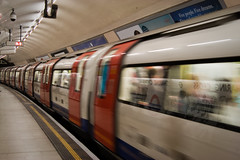 There are vast and impressive underground rapid-transit systems in many cities around the globe, but the London Underground (a.k.a. "The Tube") was the first. It was also the first to use electric trains, has more stations than any other, and includes more track than any but Shanghai's. The Tube has been around so long there are dozens of abandoned stations, some many decades out of use. It also inspired one of the world's truly great maps, and even several typefaces. Personally, on my one visit to London in 1985, it simply amazed me how easy (though disorienting) it was to be in one place, descend under the city, take a train, and end up somewhere else.
There are vast and impressive underground rapid-transit systems in many cities around the globe, but the London Underground (a.k.a. "The Tube") was the first. It was also the first to use electric trains, has more stations than any other, and includes more track than any but Shanghai's. The Tube has been around so long there are dozens of abandoned stations, some many decades out of use. It also inspired one of the world's truly great maps, and even several typefaces. Personally, on my one visit to London in 1985, it simply amazed me how easy (though disorienting) it was to be in one place, descend under the city, take a train, and end up somewhere else.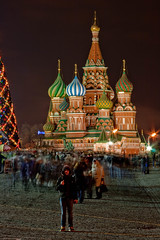 Moscow's Red Square really is something. Outlasting both the czars and the Blosheviks, it has been the city's hub, from which the spokes of Moscow's roads emanate, for more than 500 years, centuries before the Soviets put Lenin's Tomb on one side. I visited not long after Mikhail Gorbachev took power in the U.S.S.R. (again in 1985), so Red Square was still the hub of world Communism. But standing in it, despite the indelible images of huge military parades in my mind, it transcended such a narrow focus. The fantasy onion domes of St. Basil's Cathedral, the imposing facade of the GUM department store, the Kremlin wall—history mashed itself together while I stood in the gigantic cobbled space of the Square itself. There was no doubt: I was in Russia, dammit, and it was a genuine, historic place, not simply the domain of Red Scare boogeymen.
Moscow's Red Square really is something. Outlasting both the czars and the Blosheviks, it has been the city's hub, from which the spokes of Moscow's roads emanate, for more than 500 years, centuries before the Soviets put Lenin's Tomb on one side. I visited not long after Mikhail Gorbachev took power in the U.S.S.R. (again in 1985), so Red Square was still the hub of world Communism. But standing in it, despite the indelible images of huge military parades in my mind, it transcended such a narrow focus. The fantasy onion domes of St. Basil's Cathedral, the imposing facade of the GUM department store, the Kremlin wall—history mashed itself together while I stood in the gigantic cobbled space of the Square itself. There was no doubt: I was in Russia, dammit, and it was a genuine, historic place, not simply the domain of Red Scare boogeymen.
My school group took an overnight train 400 miles from Moscow to St. Petersburg (still known as Leningrad at the time). That city is as close as I've ever come to my maternal grandparents' home country of Finland. My key memory of Leningrad is really the bone-chilling winter wind across the Neva River, but the place that made the biggest impression was the Hermitage Museum, which encompasses six huge buildings along the riverbank, and contains the largest collection of paintings in the world. It is the stereotype of what you think of as a classical museum: room after ornate room of sculptures, pictures, jewelry, antiquities, and more, stretching beyond your ability to comprehend. We had merely part of the day to see a fraction of the Hermitage, and I was a somewhat-skittish teenager, so I didn't pay as close attention as I should have. Still, I haven't forgotten it.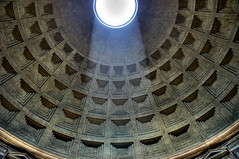 The most peculiar thing about Rome is that you can be walking down a modern, bustling city street, like you might see in any city, then turn a corner and confront any number of huge ancient marvels, right there in the middle of everything. The Pantheon is one of those. First you see the ranks of stone columns holding up the entranceway. Then, go inside and you stand under what is still the world's largest unsupported concrete dome, constructed in honour of the bustling throng of ancient Greco-Roman gods, and lit by daylight streaming through the central oculus at the apex. It is a masterpiece of architecture and engineering, still astonishing for its beauty and symmetry: the crown of the roof, for instance, is 58 m above the floor, and the dome is exactly the same diameter. It would be an amazing achievement to build today; the Romans made it almost 2000 years ago.
The most peculiar thing about Rome is that you can be walking down a modern, bustling city street, like you might see in any city, then turn a corner and confront any number of huge ancient marvels, right there in the middle of everything. The Pantheon is one of those. First you see the ranks of stone columns holding up the entranceway. Then, go inside and you stand under what is still the world's largest unsupported concrete dome, constructed in honour of the bustling throng of ancient Greco-Roman gods, and lit by daylight streaming through the central oculus at the apex. It is a masterpiece of architecture and engineering, still astonishing for its beauty and symmetry: the crown of the roof, for instance, is 58 m above the floor, and the dome is exactly the same diameter. It would be an amazing achievement to build today; the Romans made it almost 2000 years ago.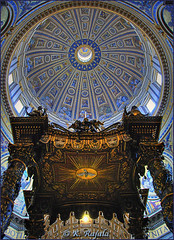 If you want evidence that the Dark Ages really were a stagnant time, go across town in Rome to the buildings of the Vatican. It took a millennium and a half for architecture and art to surpass the achievements of the Roman Empire, so these magnificent structures are mere youngsters compared to the Pantheon or the Colosseum. Michelangelo painted the dome of the Sistine Chapel 500 years ago, and the dome of St. Peter's Basilica was finished even more recently, in 1590. St. Peter's itself is awe-inspiring, but also overwrought: every interior surface is festooned with gold, marble, reliefs, sculptures, relics, tombs, and intricate tile work. However, I was able to walk up the many, many steps to the top of the dome (still the world's tallest) and look out over the magnificent city—well worth the climb. And despite seeing it long before the most recent restoration, the ceiling of the Sistine Chapel and the wall featuring Michelangelo's "Last Judgment" were still mind-blowing—especially knowing some background about their controversies, then and now.
If you want evidence that the Dark Ages really were a stagnant time, go across town in Rome to the buildings of the Vatican. It took a millennium and a half for architecture and art to surpass the achievements of the Roman Empire, so these magnificent structures are mere youngsters compared to the Pantheon or the Colosseum. Michelangelo painted the dome of the Sistine Chapel 500 years ago, and the dome of St. Peter's Basilica was finished even more recently, in 1590. St. Peter's itself is awe-inspiring, but also overwrought: every interior surface is festooned with gold, marble, reliefs, sculptures, relics, tombs, and intricate tile work. However, I was able to walk up the many, many steps to the top of the dome (still the world's tallest) and look out over the magnificent city—well worth the climb. And despite seeing it long before the most recent restoration, the ceiling of the Sistine Chapel and the wall featuring Michelangelo's "Last Judgment" were still mind-blowing—especially knowing some background about their controversies, then and now.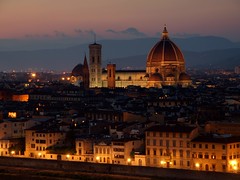 What? Three Italian domes in a row? Okay, I know it's a bit ridiculous, but each has its place in history, and its own appeal. The Piazza del Duomo (a.k.a. The Duomo) in Florence is probably the prettiest from the outside, with the dome's distinctive white marble sides and red top matched by its bell tower. The dome was created by Brunelleschi, the tower in part by Giotto. Together they were the nucleus of the Renaissance beginning in the 1300s, where artists finally figured out how to paint with realistic perspective by rendering the buildings of the Duomo on canvas. In my brief school tour of Italy in 1986, the historic centre of Florence—with red tile roofs as far as the eye can see, surrounded by Tuscan hills—was my favourite part.
What? Three Italian domes in a row? Okay, I know it's a bit ridiculous, but each has its place in history, and its own appeal. The Piazza del Duomo (a.k.a. The Duomo) in Florence is probably the prettiest from the outside, with the dome's distinctive white marble sides and red top matched by its bell tower. The dome was created by Brunelleschi, the tower in part by Giotto. Together they were the nucleus of the Renaissance beginning in the 1300s, where artists finally figured out how to paint with realistic perspective by rendering the buildings of the Duomo on canvas. In my brief school tour of Italy in 1986, the historic centre of Florence—with red tile roofs as far as the eye can see, surrounded by Tuscan hills—was my favourite part.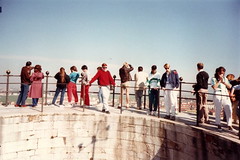 The Leaning Tower of Pisa has always leaned. In fact, if there hadn't been a hundred-year war-driven interruption in its construction (which let the soil settle), it likely would have collapsed before it was finished, so flawed was its original design and placement. And if the tower were entirely leveled out, it would still curve a little to one side, because its floors were constructed asymmetrically in the 13th century to try to compensate for the tilt. However, it no longer leans as much as it used to, and it's no longer tilting further all the time: restoration and counterweighting completed in 2001 have stopped it. But when I visited, it was still moving, and leaning about as far as it ever did—about 5.5°. My friends and I scaled the steps to the top, which I believe you're now allowed to do again. It's worth doing, because the tower is such a cliché on so many badly-painted walls of cheap Italian restaurants and pizza joints around the world. But it's real, and yes it does lean like that.
The Leaning Tower of Pisa has always leaned. In fact, if there hadn't been a hundred-year war-driven interruption in its construction (which let the soil settle), it likely would have collapsed before it was finished, so flawed was its original design and placement. And if the tower were entirely leveled out, it would still curve a little to one side, because its floors were constructed asymmetrically in the 13th century to try to compensate for the tilt. However, it no longer leans as much as it used to, and it's no longer tilting further all the time: restoration and counterweighting completed in 2001 have stopped it. But when I visited, it was still moving, and leaning about as far as it ever did—about 5.5°. My friends and I scaled the steps to the top, which I believe you're now allowed to do again. It's worth doing, because the tower is such a cliché on so many badly-painted walls of cheap Italian restaurants and pizza joints around the world. But it's real, and yes it does lean like that. Our last stop in Italy might be the most amazing: the City of Venice. How did it ever get built, a whole city that seems afloat, but is instead inundated by design (though the Venetians of the past didn't count on rising sea levels), and that even today houses 60,000 people living on deep-driven piles on the surface of the sea? The old city is Europe's largest car-free area—unique, beautiful, filled with fabulous architecture, art, museums, restaurants, stores, bridges, cobbled walking streets, and canals, of course. (It can be smelly too.) I was heavily overcharged for a simple Coke in the Piazza San Marco, ostensibly for the tunes played by live musicians between outdoor tables at our restaurant. But I didn't care. There is no place else like it.
Our last stop in Italy might be the most amazing: the City of Venice. How did it ever get built, a whole city that seems afloat, but is instead inundated by design (though the Venetians of the past didn't count on rising sea levels), and that even today houses 60,000 people living on deep-driven piles on the surface of the sea? The old city is Europe's largest car-free area—unique, beautiful, filled with fabulous architecture, art, museums, restaurants, stores, bridges, cobbled walking streets, and canals, of course. (It can be smelly too.) I was heavily overcharged for a simple Coke in the Piazza San Marco, ostensibly for the tunes played by live musicians between outdoor tables at our restaurant. But I didn't care. There is no place else like it. Let's cross several oceans and continents to the other side of the globe. I've never been to Sydney, Australia—I merely stopped over at the airport on the way to and from the Melbourne Music Festival with my band in 1995. Yet the city left a lasting impression because of the aerial view I had of Sydney Harbour, the largest natural harbour in the world. As we descended, I marveled at the intricate convolutions of the submerged valleys that form Port Jackson, and suddenly the worldwide beach-going reputation of Sydneysiders made sense. I wanted to come back and see the place from ground level, but I never did.
Let's cross several oceans and continents to the other side of the globe. I've never been to Sydney, Australia—I merely stopped over at the airport on the way to and from the Melbourne Music Festival with my band in 1995. Yet the city left a lasting impression because of the aerial view I had of Sydney Harbour, the largest natural harbour in the world. As we descended, I marveled at the intricate convolutions of the submerged valleys that form Port Jackson, and suddenly the worldwide beach-going reputation of Sydneysiders made sense. I wanted to come back and see the place from ground level, but I never did.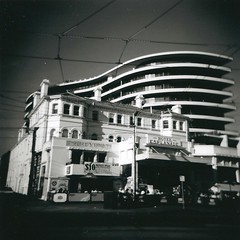 My final favourite place on this list is more prosaic than the rest, and rather newer. Unless you know about it while driving by, you might not necessarily notice the Esplanade Hotel (a.k.a. The Espy), across from St. Kilda Beach in Melbourne. But it is the oldest continuously operating live music venue in the country, originally built in 1878. Numerous attempts to redevelop the site have met with furious protests from residents of the city, because The Espy is legendary. In 1995, my band The Flu took out a loan to fly to Australia to be part of the Melbourne Music Festival, and The Espy was one venue we played, as well as seeing several other acts there during the month we were in town. I recall it as a building where I've had some of the most fun in my life. If The Flu had become the international pop-rock phenomenon we were trying to be, I would identify this as the place where that really got started. Since it didn't happen, I think of The Espy as the place where that could have gotten started.
My final favourite place on this list is more prosaic than the rest, and rather newer. Unless you know about it while driving by, you might not necessarily notice the Esplanade Hotel (a.k.a. The Espy), across from St. Kilda Beach in Melbourne. But it is the oldest continuously operating live music venue in the country, originally built in 1878. Numerous attempts to redevelop the site have met with furious protests from residents of the city, because The Espy is legendary. In 1995, my band The Flu took out a loan to fly to Australia to be part of the Melbourne Music Festival, and The Espy was one venue we played, as well as seeing several other acts there during the month we were in town. I recall it as a building where I've had some of the most fun in my life. If The Flu had become the international pop-rock phenomenon we were trying to be, I would identify this as the place where that really got started. Since it didn't happen, I think of The Espy as the place where that could have gotten started.
Had I been to more places around the world in my life, I'm sure this list and its two predecessors would be different. But these are the places I have seen, and liked. If you choose to go to any of them, perhaps you will too.

Have seen 7 out of those 10 places. Have spent quite a bit of time at the Espy since I was 16 (sneak in to see bands!). Dropped by the Espy a few weeks ago for a birthday drink. Has changed slightly the last couple of years (including major hike in price of drink), but still has that grunge feel about it!
I haven't been further east than Italy, but your recounting (heh) of the 426 steps up to the top of St Peter's inspired me to find this link to the panorama I stitched together from a few shots from the top:
https://www.flickr.com/photos/docjelly/528796658/
What year did you go to Russia? I went on a school trip that sounds remarkably similar to yours.
It was spring break, March 1985.
I was there in March of 1989, some sort of "youth ambassador" program. After reading your post again, I realize my trip was a little different. We flew into Helsinki, spent a day there, then took the overnight train to St. Petersburg/Leningrad, spent a few days there (the Hermitage was indeed amazing), and then another long train ride to Moscow.
I saw a band remarkably like yours at the Espy (at least the incarnation where you dress up like Austin Powers). They did three sets of covers - one 60s music, one 70s, and one 80s. They changed costumes to match the theme of each set. This would have been about 1998. A Maximizer employee from the Melbourne office was on guitar. I want to say they were called the Retrosexuals, but I may be remembering someone else (maybe even you guys?)
Definitely not us. We never went back to Australia after 1995.